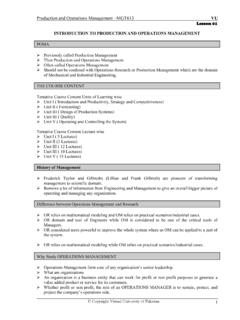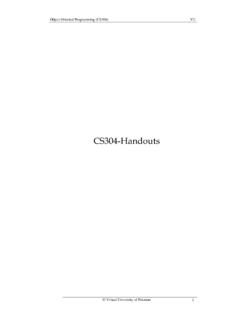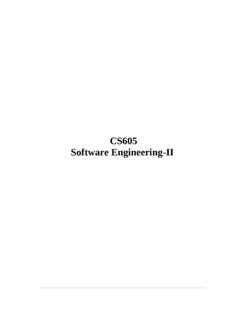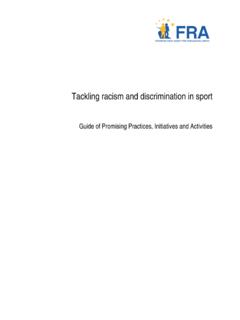Transcription of Introduction to Psycholinguistics (ENG511) - vulms.vu.edu.pk
1 Introduction to Psycholinguistics (ENG511). Psycholinguistics (ENG511). VIRTUAL UNIVERSITY OF PAKISTAN. Psycholinguistics (ENG511) VU. Table of Contents Pg. Lesson No. Lesson Title Topics No. Introduction TO Psycholinguistics . Introduction to Psycholinguistics 01 1. The Nature of Language: Psycholinguistics 02 1. Lesson No. 1 The Scope of Psycholinguistics 03 1. Language Processes and Linguistic Knowledge 04 2. The Historical Context 05 2. Early Psycholinguistics 06 3. THE CONNECTION BETWEEN Psycholinguistics AND. NEUROLINGUISTICS. The Information-Processing System 07 4. Working Memory and Long term Memory 08 4. Lesson No. 2. Central Issues in Language Processing 09 4. Examples of Language Processing 10 5. Development of Processing System 11 5. Developing Working and Long Term Memory 12 5. LANGUAGE COMPREHENSION.
2 Perception of Language 13 7. The Structure of Speech 14 7. Lesson No. 3 Perception of Isolated Speech Segments 15 7. The Motor Theory of Speech Perception 16 7. Perception of Continuous Speech 17 8. Perception of Written Language 18 8. DIMENSIONS OF WORD KNOWLEDGE. Phonological Knowledge 19 9. Phonological Knowledge: Conceptual and Empirical Issues 20 9. Syntactic Knowledge 21 10. Lesson No. 4 Children's Acquisition of Syntactic Knowledge 22 10. Morphological Knowledge 23 11. Evaluating the Effectiveness of a Morphological Awareness Intervention 24 12. ORGANIZATION OF THE INTERNAL LEXICON. Semantic Knowledge 25 14. The Concept of a Semantic Network 26 14. Lesson No. 5. Hierarchical Network Models 27 15. Spreading Activation Models 28 15. Advantages and Disadvantages of Semantic Differential Scale 29 16.
3 Semantic Barriers 30 16. i Psycholinguistics (ENG511) VU. LEXICAL ACCESS. Models of Lexical Access 31 17. Difference Between Logogen and Cohort Model 32 18. Lesson No. 6 Variables that Influence Lexicon Access 33 19. Lexical Ambiguity 34 19. Appraising Models of Lexical Access 35 19. Stages of Lexis in Speech Production 36 19. IMMEDIATE PROCESSING OF SENTENCE. Parsing 37 21. Parsing Strategies 38 22. Lesson No. 7 Modular Versus Interactive Models 39 23. Constraint Based Model 40 23. Working Memory and Comprehension 41 24. Incomplete or Inaccurate Representations 42 24. COMPREHENDING FIGURATIVE LANGUAGE. Comprehending Figurative Language 43 25. Types of Figurative Language 44 25. Lesson No. 8 Studies of Figurative Language Comprehension 45 26. Comparison and Contrast Pragmatic Theory and Conceptual Metaphor Theory 46 26.
4 Class Inclusion Theory 47 26. Comparative Figurative Languages 48 26. MEMORY FOR SENTENCES. Memory for Meaning Versus Surface Form 49 29. Time Course of Retention and Pragmatic Factor 50 29. Lesson No. 9 Inferences and Sentence Memory 51 29. False Recognition Errors 52 29. Propositions and Sentence Memory 53 30. Analysis of Propositions, Sentences, and Clause type 54 30. COMPREHENSION OF DISCOURSE. Local and Global Discourse Structure 55 31. Discourse Structure: Theory, Practice, and Use 56 31. Lesson No. 10 Cohesion 57 31. Strategies Used to Establish Coherence 58 31. Identifying New Topics of Discourse 59 32. Role of Working Memory 60 33. MEMORY FOR DISCOURSE. Memory for Discourse 61 34. Surface Representations 62 34. Lesson No. 11 Propositional Representations 63 34. Inferences and Propositional Representations 64 35.
5 Situational Models 65 35. Simultaneous Investigations of all Three Levels 66 35. ii Psycholinguistics (ENG511) VU. SCHEMATA AND DISCOURSE PROCESSING. Schemata 67 36. Genres 68 36. Lesson No. 12 Narrative Discourse Processing 69 37. Inaccessibility of Knowledge 70 37. Identifying the Main Points 71 38. Building Global Structures 72 38. THE PSYCHOLOGY OF LEARNING. Sign Language: A True Language Without Speech 73 39. Speech-Based Sign Languages 74 39. Lesson No. 13 Basic Grammatical Concepts 75 39. Insights from Sign Language 76 40. Transformational Grammar 77 40. Issues in Grammatical Theory 78 41. PRODUCTION OF SPEECH AND LANGUAGE. Introduction of Production of Speech Language 79 43. Slips of Tongue 80 44. Lesson No. 14. Types of Error Speech 81 45. Common Properties of Speech Error 82 46. Explanations of Speech Errors 83 46.
6 Differences in Freudian and Psycholinguistics Explanation 84 46. FORMULATING LINGUISTIC PLANNING. Serial Models of Linguistic Planning 85 48. Independence of Planning Unit 86 48. Lesson No. 15 Editing Processes 87 48. Freud's View of Slips of Tongue 88 49. Parallel Models of Linguistic Planning 89 49. The Role of Agreement 90 50. IMPLEMENTING LINGUISTIC PLANS. Articulating Planning and Production Cycles Articulating 91 51. Planning and Production Articulating Cycle 92 51. Lesson No. 16 Self-Monitoring 93 51. Editing Expressions 94 51. Insights from Sign Language 95 51. Production Rate 96 52. THE STRUCTURE OF CONVERSATION. The Structure of Conversation 97 53. Opening Conversations 98 53. Lesson No. 17 Closing Conversations 99 53. Taking Turns 100 54. Negotiating Topics of Conversations 101 55. Identifying Participants and Nonparticipants 102 55.
7 CONVERSATIONAL PARTICIPANTS. Lesson No. 18 Friends and Acquaintance 103 57. Gender Differences in Conversation 104 57. iii Psycholinguistics (ENG511) VU. More Recent Work on Interpreting the Conversational Strategies 105 57. Conversational Settings 106 57. Therapeutic Discourse 107 57. Other Forms of Institutional Discourse 108 58. EARLY LANGUAGE ACQUISITIONS. Prelinguistic Communication 109 59. Prelinguistic Gestures 110 59. Lesson No. 19 Early Phonology 111 59. Early Words on Lexical Development 112 60. Early Grammar 113 60. Emergence of Grammatical Categories 114 60. LATER LANGUAGE ACQUISITIONS. Later Grammar 115 62. Cross-Linguistics Differences in Later Grammar 116 62. Lesson No. 20 Metalinguistic and Discourse 117 62. Discourse Processes in Children 118 62. Language in School 119 62. Reading and Language Development 120 62.
8 BILINGUALISM AND SECOND LANGUAGE ACQUISITIONS. Contexts of Childhood & Bilingualism 121 64. Bilingual First-Language Acquisitions 122 64. Lesson no. 21 Second Language Acquisitions 123 64. Metalinguistic Awareness 124 65. Cognitive Control 125 65. Problem Solving and Creativity 126 65. THE LINGUISTIC ENVIRONMENT. Introduction of Process of Language Acquisition 127 67. Feral and Isolated Children 128 67. Lesson No. 22 The Critical Period Hypothesis 129 67. Critical Period Effects in Second Language Learning 130 68. Motherese 131 68. Some Characteristics of Adult Speech to Children 132 68. COGNITIVE PROCESSES. Cognitive Processes 133 69. Operating Principles 134 69. Lesson No. 23 Sensorimotor Schemata 135 69. Whole Object Bias and Taxonomic Bias 136 70. Mutual Exclusivity Bias 137 71. Impairments of Language and Cognition 138 71.
9 INNATE MECHANISM. The Language Bio program Hypothesis 139 72. The Language Bio program 140 72. Lesson No. 24. Parameter Setting 141 73. The Subset Principle 142 73. The Issues of Negative Evidence 143 73. iv Psycholinguistics (ENG511) VU. Objections to Innate Mechanisms 144 74. BRIAN MECHANISM AND LANGUAGE. Broca's Aphasia 145 75. Wrecks' and Conduction Aphasia 146 75. Lesson No. 25 Other Aphasias 147 76. Geschwind's Models of Language Processing 148 76. Experimental Studies of Aphasia 149 77. Implications for Understanding Normal Language Processing 150 77. LATERALIZATION OF LANGUAGE PROCESSES. Split-brain Research 151 78. Lateralization in Normal Brains 152 78. Lesson No. 26. Contributions of the Right Hemisphere 153 78. Aphasia in Children and Hemispherectomy Studies 154 79. Behavioral and Psychological Studies 155 79.
10 Development of Lateralization & Lateralization in Other Species 156 79. EVOLUTION OF LANGUAGE. Evolution of Language 157 81. Communication in Present Day Primates 158 81. Teaching Language to Nonhuman Primates 159 81. Lesson No. 27 The Continuity Debate 160 81. Gesture and Speech as Possible Evolutionary Sequences 161 82. Brain Size and Social Behaviour as Possible Evolutionary Sequences 162 82. LANGUAGE, CULTURE AND COGNITION. The Whorf Hypothesis 163 84. Linguistic Determination and Relativity 164 84. Some Whorfian Examples: Lexical Examples 165 84. Lesson No. 28. Grammatical Examples 166 85. Criticism on Whorf Hypothesis 167 86. Sapir-Whorf Hypothesis: Limitations and Possibilities 168 87. THEORIES ON CULTURE AND LANGUAGE. Theories on Language & Culture: Theory 1: Speech is Essential for Thought 169 88.














